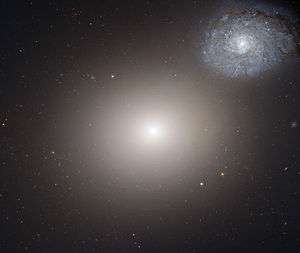Messier 60
| Messier 60 | |
|---|---|
|
M60 by Hubble Space Telescope; 3.33′ view | |
| Observation data (J2000 epoch) | |
| Constellation | Virgo[1] |
| Right ascension | 12h 43m 39.6s[2] |
| Declination | +11° 33′ 09″[2] |
| Redshift | 0.003726[2] |
| Helio radial velocity | 1117 ± 6 km/s[2] |
| Distance (comoving) | 16.8 ± 1.2 Mpc |
| Distance | 55 ± 4 Mly (16.8 ± 1.2 Mpc)[3] |
| Apparent magnitude (V) | 9.8[2] |
| Characteristics | |
| Type | E2[2] |
| Apparent size (V) | 7′.4 × 6′.0[2] |
| Other designations | |
|
M60, NGC 4649,[2] UGC 7898,[2] PGC 42831[2] Arp 116,[2] GC 3182.[2] | |
Messier 60, also known as NGC 4649, is an elliptical galaxy approximately 55 million light-years away[3] in the constellation Virgo. It is part of a pair of galaxies known as Arp 116 with NGC 4647.[4]
History
Messier 60 and the nearby galaxy Messier 59 were both discovered by Johann Gottfried Koehler in April 1779 during observations of a comet in the same part of the sky.[5] Charles Messier listed both in the Messier Catalogue about three days after Koehler's discovery.[5]
Neighbourhood
Overlapping galaxy NGC 4647
NGC 4647 appears approximately 2′.5 away from Messier 60; the optical disks of the two galaxies overlap. Although this overlap suggests that the galaxies are interacting, photographic images of the two galaxies do not reveal any evidence for gravitational interactions between the two galaxies as would be suggested if the two galaxies were physically close to each other.[6] This suggests that the galaxies are at different distances and are only weakly interacting if at all.[6] However, recent studies by the Hubble Space Telescope show indications that tidal interactions may have just begun.[4] The pair together is collectively known as Arp 116 (APG 116).[4]
Satellites
M60 has several satellite galaxies. One of them is the ultracompact dwarf galaxy M60-UCD1.[7]
Virgo Cluster membership
M60 is the third-brightest giant elliptical galaxy of the Virgo cluster of galaxies, and is the dominant member of a subcluster of four galaxies, which is the closest-known isolated compact group of galaxies.
Supernovae
In 2004, supernova SN 2004W was observed in Messier 60.[8]
Black Hole
At the center of M60 is a black hole of 4.5 billion solar masses, one of the largest ever found.[9]
Gallery
 Arp 116 is composed of a giant elliptical galaxy known as Messier 60, and a much smaller spiral galaxy, NGC 4647.
Arp 116 is composed of a giant elliptical galaxy known as Messier 60, and a much smaller spiral galaxy, NGC 4647. M60 and NGC 4647
M60 and NGC 4647.jpg) M60 and the region around it, including the ultra-compact dwarf galaxy M60-UCD1.
M60 and the region around it, including the ultra-compact dwarf galaxy M60-UCD1.
See also
References
- ↑ R. W. Sinnott, ed. (1988). The Complete New General Catalogue and Index Catalogue of Nebulae and Star Clusters by J. L. E. Dreyer. Sky Publishing Corporation /Cambridge University Press. ISBN 0-933346-51-4.
- 1 2 3 4 5 6 7 8 9 10 11 12 "NASA/IPAC Extragalactic Database". Results for Messier 60. Retrieved 2006-12-13.
- 1 2 J. L. Tonry; A. Dressler; J. P. Blakeslee; E. A. Ajhar; A. B. Fletcher; G. A. Luppino; et al. (2001). "The SBF Survey of Galaxy Distances. IV. SBF Magnitudes, Colors, and Distances". Astrophysical Journal. 546 (2): 681–693. arXiv:astro-ph/0011223
 . Bibcode:2001ApJ...546..681T. doi:10.1086/318301.
. Bibcode:2001ApJ...546..681T. doi:10.1086/318301. - 1 2 3 "Odd Galaxy Couple On Space Voyage". Science Daily. 6 September 2012. Retrieved 2012-11-11.
- 1 2 K. G. Jones (1991). Messier's Nebulae and Star Clusters (2nd ed.). Cambridge University Press. ISBN 0-521-37079-5.
- 1 2 A. Sandage; J. Bedke (1994). Carnegie Atlas of Galaxies. Carnegie Institution of Washington. ISBN 0-87279-667-1.
- ↑ Sandoval, Michael A.; Vo, Richard P.; Romanowsky, Aaron J.; Strader, Jay; Choi, Jieun; Jennings, Zachary G.; Conroy, Charlie; Brodie, Jean P.; Foster, Caroline; Villaume, Alexa; Norris, Mark A.; Janz, Joachim; Forbes, Duncan A. (23 July 2015). "HIDING IN PLAIN SIGHT: RECORD-BREAKING COMPACT STELLAR SYSTEMS IN THE SLOAN DIGITAL SKY SURVEY". The Astrophysical Journal. 808 (1): L32. arXiv:1506.08828
 . Bibcode:2015ApJ...808L..32S. doi:10.1088/2041-8205/808/1/L32.
. Bibcode:2015ApJ...808L..32S. doi:10.1088/2041-8205/808/1/L32. - ↑ Supernova 2004W in M60
- ↑ Juntai Shen; Karl Gebhardt (2010). "The Supermassive Black Hole and Dark Matter Halo of NGC 4649 (M60)". arXiv:0910.4168
 [astro-ph].
[astro-ph].
External links
| Wikimedia Commons has media related to Messier 60. |
- StarDate: M60 Fact Sheet
- Elliptical Galaxy M60 @ SEDS Messier pages
- Messier 60 on WikiSky: DSS2, SDSS, GALEX, IRAS, Hydrogen α, X-Ray, Astrophoto, Sky Map, Articles and images
Coordinates: ![]() 12h 43m 39.6s, +11° 33′ 09″
12h 43m 39.6s, +11° 33′ 09″

